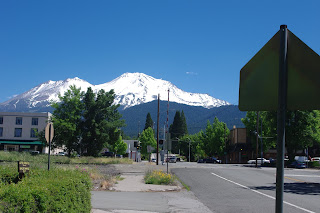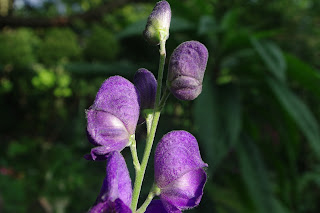A diary of back garden botany, urban ecology, rural rambles and field trips to the middle of nowhere...
Friday, 30 June 2017
A recent visitor said the garden was nice but could do with a tidy up. I think that's a bit harsh- I cut the grass as often as twice a year.
Bear's Breech (Acanthus mollis) thrives under the apple tree, although the leaves have become wilted and parched with the lack of rain. It throws up striking spikes of flowers and in fact flowers more when times are tough.
I notice bumblebees particularly love the flowers on the bramble bushes. This is encouraging given how much bramble there is in overgrown parts of town and country.
I've been growing lettuce in a planter as a cut and come again crop, now there's a glut. I remembered a recipe for lettuce soup to use it up- it's delicious. When lettuce is cooked it goes dark green like spinach and tastes similar.
The runner beans are coming on in the tub alongside.
Jasmine grows along part of the wooden fence on the south side of the garden forming a hedge of sorts. It has a delicious fragrance as night falls to attract pollination by moths.
It doesn't get much more humble than this or much lovelier. Heartsease (Viola tricolor), an annual grown from seed in a pot on a window sill.
Thursday, 29 June 2017
This is Motherwort (Leonurus cardiaca). Gerard's Herball of 1597 states that "It joys to be among rubbish, in stony and other rough places, especially about Oxford".
It grows happily in part sun/shade in the garden but Gerard's description suggests that it spread as weeds/wildflowers are prone to do on the margins of human habitation.
As I noted in my earlier entries on Lungwort (3rd. March) and Nipplewort (4th. June) the word "wort" in the common name of a plant indicates that it was once perceived to have a medicinal use. In some cases this may be purely notional. Both of these names for example probably date back to the medieval "Doctrine of Signatures" i.e. if a plant resembles a part of the human body it was thought there would be a corresponding medicinal effect.
Then again there are plants like Motherwort that seem to have a long history as a herbal remedy, in this case for nerve and heart conditions generally and female health in particular.
I don't have a scientific or medical background to assess herbalism as a practice but I'm intrigued by the social and cultural history of plants as much as with botany and horticulture.
Also I like growing plants for bees and Motherwort is a noted bee plant!
Monday, 26 June 2017
I can't resist a few more photos of the gorgeous flowers of Meadow Cranesbill (Geranium pratense) from my trip to Wiltshire last week (see entry below). The veined flowers are essentially of a blue hue but vary from very pale to almost purple, sometimes flushed with hints of violet and even a pinkish tinge here and there.
The stalks often stand quite tall among the surrounding grasses and this airy quality makes them particularly evocative of mid-summer in the countryside.
Sunday, 25 June 2017
Memories of a solstice II. Last year I was in California (see entry below), this year... Wiltshire. I walked a section of the Kennet and Avon canal from Bedwyn to Wilcot then pitched my tent in a field to watch the sunset over the rolling chalk hills beyond. The following day I walked up onto those hills where the vistas stretch for miles.
Actually there was an American aspect to my ramblings. I'm heading out to the States next month- a few days in San Fransisco again, then the same Amtrak route but this time going further to southern Oregon to camp and hike in the Crater Lake National Park area. I wanted to make sure all my camping gear was functional and it was good practice to do a bit of a route march with a full pack on the hottest day of the year.
To be honest the towpath is fairly gentle and the field was behind a pub that serves a cracking pint so I'm easing myself into the wilderness gently.
The banks of the canal were lined with the fluffy, creamy flowers of Meadowsweet (Filipendula ulmaria). I headed for the hills up the Workway Drove, an ancient drover's track where the lovely azure flowered Meadow Cranesbill (Geranium pratense) pops up all over the place.
Wednesday, 21 June 2017
Memories of a solstice. This time last year I was in California. I stayed in San Francisco for several days visiting my friends James and Komoot. It was great to see my old friend James again and to meet his partner Komoot, she is a wonderful person.
Then on this day a year ago I boarded the Amtrak Coast Starlight and traveled overnight to Dunsmuir in the far north of the state. I took a bus to the nearby town of Shasta then a cab to the Bunny Flats trailhead on Mount Shasta itself. This is a popular starting point for routes around Shasta, particularly for mountaineers heading up beyond the treeline. I walked off into the woods to pitch my tent and do some hiking.
In 1874 the pioneering naturalist John Muir said of Mount Shasta:
"When I first caught sight of it over the braided folds of the Sacramento Valley, I was fifty miles away and afoot, alone and weary. Yet all my blood turned to wine and I have not been weary since".
Right on John! I first saw it at dawn framed by a window on the Amtrak as the train made its way through mountains and valleys- truly an extraordinary sight.
I camped at about seven thousand feet. A thousand foot higher (about an hours walk uphill) the snow still lay thick on the ground. I particularly wanted to see an area known as Panther Meadows; partly because it is a notable example of an alpine flower meadow and partly because this was my nearest source of water (strange to be in a hot, dry environment in sight of gleaming white snow).
The first day I visited the meadows they were covered in snow. I had come to see flowers but I could not be disappointed to be in this pristine place. And then I saw a miracle of life unfold.
I went back the next day to get water from the bubbling streams. The snow had half melted and brown and green shades of vegetation were exposed. I went back the following day: the snow was mostly gone and the first flowers were starting to bloom!
This carpet of petite alpines had been under snow for nine months but they wasted not a moment in showing their colours. This is characteristic of snowbound regions- summer is brief and the flowering intense. In September it starts to snow again.
Had I arrived a week later I would have seen the meadows in full flower, then again the week before there had been two and a half feet of snow. The timing of these slender margins varies each year but those days of seeing the meadows emerge will stay with me always.
Lower down where I camped beneath the pines among flowery shrubs I have to leave the last words to John Muir. In his essay Shasta Bees from 1875 he wrote:
"In June the base of Mount Shasta will be as white with honey as the summit with snow. Follow the bees and be showered with blossoms; take a baptism and a honey-bath and get some sweetness into your lives".
Right on John!
Tuesday, 20 June 2017
Monday, 19 June 2017
Monk's Hood (Aconitum napellus) is a very poisonous plant. All parts of it are toxic and potentially fatal if ingested. It grows into a tall spire of indigo flowers, seen here at the tip. To my eye they do indeed resemble a cowled head.
The Latin name may be more useful to botanists but the common name coveys a somewhat sinister feeling which is justified- beautiful as it is.
Sunday, 18 June 2017
The Common Mallow (Malva sylvestris) is particularly common in coastal areas- these photos were taken over the weekend near Whitstable. The honey bee is absolutely dusted in the pollen of the flowers (as with all photos in this diary clicking on it for the larger version brings out some of the finer detail).
Friday, 16 June 2017
I took a walk along the River Lee in glorious sunshine from Hackney Wick to Cheshunt. This stretch of the river runs alongside the Hackney, Walthamstow and Tottenham marshes and into the Lee Valley Park area- survivals of an older landscape within the bounds of Greater London.
The selection of photos above is taken from visits over the past few years in June/July. Nature abounds and some plants thrive in greater profusion here than I have seen in rural locations; Comfrey, Meadowsweet, Purple Loosestrife, Common Mallow, Goat's-rue and Rosebay Willowherb among them.
I enjoy the writings of Richard Mabey whose first book was published in the early 1970s. It describes his explorations of London's urban and industrial margins and the patchwork of native plants and others from all over the world that grow in these surroundings. He gave this book a title which seems very apt: "The Unofficial Countryside".
Tuesday, 13 June 2017
I mentioned the Kingcombe Meadows in Dorset in a recent entry. I don't think I'll have a chance to make a trip there this year so I'm revisiting these photos from past visits.
These are ancient hay meadows and astonishingly flowery. Their survival is something of a fluke. Up until the late 1980s they had been farmed for generations by a family who raised and grazed cows and sheep never using fertilisers, pesticides or modern farming methods. I've heard it said that the matriarch of the family in particular refused to abandon the old ways or allow any money to be spent on "improving" the farm!
When the last of the line died it was put up for sale and purchased by the Dorset Wildlife Trust as a working farm and nature reserve. I imagine this family of farmers had no thought of being ecologists or conservationists as such but throughout the twentieth century they preserved an environment which gives an insight into how the countryside must have looked going back hundreds of years.
Thanks to them these fields contain remarkable displays of meadow plants such as Betony, Field Scabious and Greater Knapweed growing among many different grasses, not to mention an amazing array of orchids, Foxgloves in the hedgerows and so much more. The bio-diversity of this special place is endless.
As I write this I recall the sight of a barn owl circling low at twilight, butterflies I've never seen before, bats at night, bees all day long. I'm going to stop writing now and wander through those meadows in my mind.
Subscribe to:
Comments (Atom)

















































